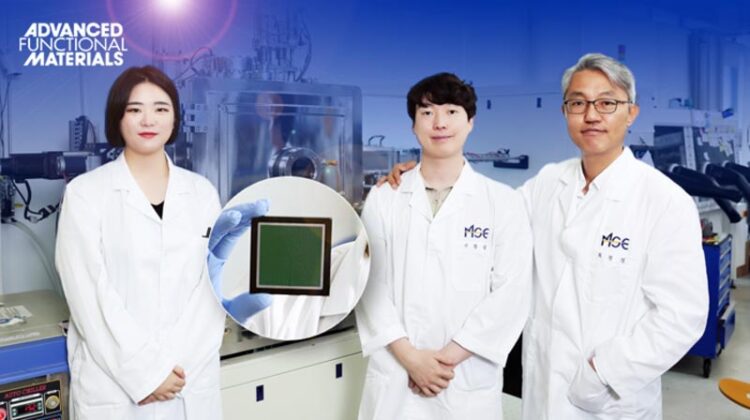Ways to improve light absorption in perovskite/si tandem solar cells

Professor Kyoung Jin Choi and his research team in the Department of Materials Science and Engineering at UNIST.
Credit: UNIST
A research team, affiliated with UNIST has succeeded in achieving a power conversion efficiency (PEC) of 23.50% in a perovskite-silicon tandem solar cell built with a special textured anti-reflective coating (ARC) polymeric film. According to the research team, the PCE of the device with the ARC film was sustained for 120 hours, maintaining 91% of its initial value.
This breakthrough has been led by Professor Kyoung Jin Choi and his research team in the Department of Materials Science and Engineering at UNIST, in collaboration with Professor Jung-Kun Lee and his research team from the University of Pittsburgh in the United States.
In the work, the research team systematically demonstrated that a combination of silicon dioxide (SiO2) nanoparticles and large phosphor particles can convert ultraviolet (UV) to visible light and increase total transmittance of ARC film. Their experimental and computational results also show that SiO2 nanoparticles in the ARC film decrease the reflectance by increasing the diffuse transmittance.
Moreover, the PCE of the device with the ARC film was sustained for 120 hours, maintaining 91% of its initial value, while the PCE of existing devices dropped to 90% of its initial efficiency after 5 hours, and then decreased to 50% after 20 hours. In addition, the initial efficiency of the solar cell has also increased by nearly 4.5% compared to the previous one.
“This optically engineered ARC film successfully promotes the light absorption of the perovskite/silicon tandem solar cell, leading to the improvement of power conversion efficiency of the tandem cell from 22.48% to 23.50%,” noted the research team.
The findings of this research were made available in the online edition of Advanced Functional Materials, ahead of its publication in August 2022. This study has been jointly participated by Seongha Lee (Department of Mechanical Engineering and Material Science, University of Pittsburgh) and Chan Ul Kim (Department of Materials Science and Engineering, UNIST).
Journal Reference
Seongha Lee,Chan Ul Kim,Sumin Bae, et al., “Improving Light Absorption in a Perovskite/Si Tandem Solar Cell via Light Scattering and UV-Down Shifting by a Mixture of SiO2 Nanoparticles and Phosphors,” Adv. Funct. Mater., (2022).
Journal: Advanced Functional Materials
Article Title: Improving Light Absorption in a Perovskite/Si Tandem Solar Cell via Light Scattering and UV-Down Shifting by a Mixture of SiO2 Nanoparticles and Phosphors
Article Publication Date: 25-Aug-2022
All latest news from the category: Materials Sciences
Materials management deals with the research, development, manufacturing and processing of raw and industrial materials. Key aspects here are biological and medical issues, which play an increasingly important role in this field.
innovations-report offers in-depth articles related to the development and application of materials and the structure and properties of new materials.
Newest articles

High-energy-density aqueous battery based on halogen multi-electron transfer
Traditional non-aqueous lithium-ion batteries have a high energy density, but their safety is compromised due to the flammable organic electrolytes they utilize. Aqueous batteries use water as the solvent for…

First-ever combined heart pump and pig kidney transplant
…gives new hope to patient with terminal illness. Surgeons at NYU Langone Health performed the first-ever combined mechanical heart pump and gene-edited pig kidney transplant surgery in a 54-year-old woman…

Biophysics: Testing how well biomarkers work
LMU researchers have developed a method to determine how reliably target proteins can be labeled using super-resolution fluorescence microscopy. Modern microscopy techniques make it possible to examine the inner workings…





















